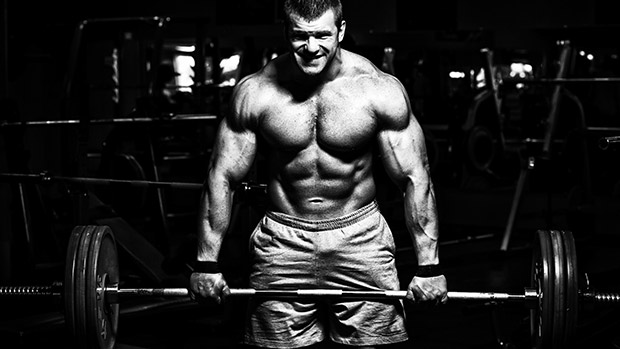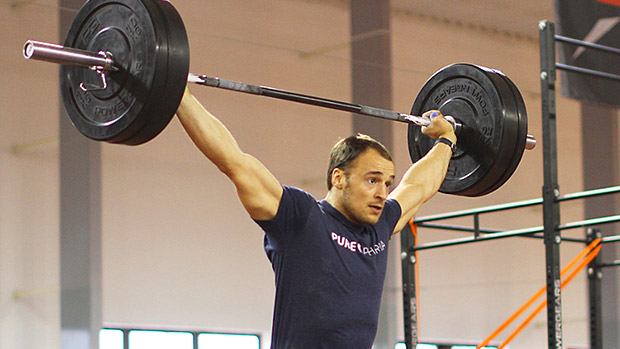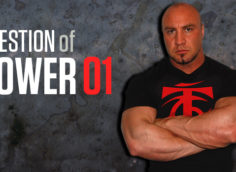It Doesn't ALWAYS Depend
I often hear coaches say, "It depends" when asked about exercise programming. According to them, "There's no black and white in strength and conditioning."
This isn't wrong, just incomplete. Why? Because there's plenty of black and white when it comes to programming, and they're called principles.
What's a principle, anyway? It's a fundamental truth that acts as the groundwork for a system of belief or behavior. So, by definition, if something is a principle, it's by nature black or white. The gray area, the "it depends" part, is found in the application of those principles.
Principles are universal, but there are many methods that allow us to use the principles. It's the application of the methods that apply to the individual. But don't confuse black-and-white with one-size-fits-all. That's not what they are. The principles are black and white, but the details are the gray areas in-between.
Here's a list (in no particular order) of the principles that'll help you design your strength training program. They're interrelated, and no matter what your strength training goal is they can help you build a lifelong foundation for it.
When many trainers talk about "sticking to the basics," they've usually got a list of certain exercises they're referring to. And they'll often judge whether a training program is good or bad based on what they deem as the basics.
They're basically "exercise memorizers" who put methods before principles because they've got a fanaticism about certain movements, or because of some allegiance to a given training method.
When we embrace the reality that a good training program isn't determined by the exercises it incorporates, but how training principles are used, we see that unless you're competing in a powerlifting or a weightlifting-oriented sport, there's no particular exercise that any athlete or gym-goer must do in order to improve. There are only training principles that must be followed, and there's a wide variety of applications and variations they can use to achieve their goals.
There are no basic exercises, just basic principles. I classify exercises as either more or less complex, but how I go about using exercises comes down to how I apply basic principles of training – specificity, individuality, progressive overload and variation.
Strength programming is really a process of decision making. And the ability to make smart programming decisions doesn't come from following trends or memorizing training models and methods from a given organization, athlete, or well-known coach. It comes from having expertise in analyzing exercises and training models based on the universal principles of training and biomechanics.
It's these principles that dictate the exercises that should be included and how they're applied in a training program... because exercises are just methods that allow us to apply principles.
A great coach today will have the same foundational qualities as a great trainer will have 10, 20, 50 and 100-plus years from now. The universal principles of training and biomechanics never go out-of-date.
A great deal of strength training info comes from the powerlifting and Olympic lifting world, meaning it's more geared toward competitive lifters. The problem is, there's a difference between people who are in the gym to become weightlifters and people who are there to become strong athletes. Not to mention, not every good athlete is a good lifter, and not every gym stud is a good athlete.
Sure, field, court, and combat athletes, as well as athletic-minded folks, can take some wisdom from weightlifting sports, but they don't need to learn or practice the sports-specific skills required to be a master weightlifter. They need only to possess basic competence in a variety of lifts in order to use them in a way that's safe and helps them to improve their overall strength and muscle.
Strength training is about building a more coordinated body that's more capable of producing, reducing, and controlling force in order to better perform a variety of movements, and be more resistant to injury when doing so.
The term "functional" is a buzzword but think of it differently here. It applies to something having a special task or purpose. So, functional capacity is your range of ability. Having higher functional capacity means you can perform a broader range of specific tasks.
That said, strength is domain/task specific. The further an exercise gets away from replicating the specific force-generation and neuromuscular coordination patterns of a given movement, the less directly it carries over to improving the force-generation and neuromuscular coordination of that specific movement.
This means field, court, and combat athletes, as well as lifters, should incorporate a wide variety of exercises to help them improve their functional capacity (their range of ability) by developing strength in various movement patterns, directions, and body positions.

A program needs to incorporate compound exercises, cross-body exercises and isolation exercises. Why? Because each offer different benefits. More specifically, each type benefits certain interdependent components of strength and functional capacity that the other category of exercise may miss.
Remember, if you can perform a broader range of specific tasks, you possess a higher functional capacity. This relationship is crucial because as an athlete or lifter, you don't want your body to be merely more adapted to a limited number of gym-based exercise movements; you want your body to be more adaptable so that you can successfully take on a variety of physical demands.
And building a stronger body that can also get things done requires several strength training components because no single type of resistance exercise will address all demands.
Muscles (and other body structures) respond to how they're loaded. They adapt. Different load placement and body position during an exercise changes the force generation and neuromuscular coordination demands of the exercise. Cross-body exercises demand a different type load placement and body position than compound exercises. Isolation exercises fill in the gaps.
So, it makes sense that taking a mixed-training approach to strength programming will provide a more comprehensive, and therefore effective, training stimulus than you'd get by using only one training method.
We get stronger by creating mechanical tension across tissues and joints by overloading them through movements, which we call resistance exercises. This is strength training.
That said, when you think less about memorizing what certain athletes and coaches say about exercises, and instead analyze exercises based on how they put force across tissues and joints, you'll see that just because you're moving through the full range of motion it doesn't mean you're training or getting stronger through that entire range.
This is what I call the "full range of motion myth." Example: Horizontal pressing exercises like bench press and push-ups effectively strengthen the muscles responsible for the motion of horizontal shoulder adduction when your arm is out to the side (when the pecs are in their mid to lengthened range), but they don't strengthen this action in the ranges of motion when your arm is in front of or across your torso (when your pecs are in their shortened range).
This is because, at the top of each rep, you're no longer working against a force that's pulling your arms apart (into horizontal shoulder adduction). So, although horizontal pressing strengthens you in the horizontal shoulder adduction, they only do so for PART of your available range of motion because they don't load this action in the ranges when your arm is in front of your torso.
Another thing you'll see when you go from memorizing exercises to analyzing exercises based up how they put force across tissues and joints is that multi-joint exercises leave a lot of joint movements untrained.
Example: Compound and cross-body exercises train the hamstrings with movements that originate at the hip joint (deadlifts, single-leg Romanian deadlifts, etc.) but neglect to train the hamstrings with a movement that originates at the knee joint (knee flexion). And research shows that not only do knee flexion exercises activate the hamstrings differently, but incorporating knee flexion exercises can improve performance and reduce hamstring injuries. And that's where the next principle comes in.
When it comes to the goal of increasing your overall strength and functional capacity, the smarter way to use isolation exercises is to train in ranges of motion and movements missed by the multi-joint (compound and cross-body) exercises.
For specific examples of isolation exercises, see The Isolation Exercise Checklist and The Missing Lower-Body Exercises for Strength.
Doing a different exercise variation for a given movement pattern or muscle group doesn't necessarily put force across tissues and joints (strengthen you) in a different manner. This means many exercise variations are redundant.
For example: Squats, deadlifts, lunges and certain variations of those exercises do a great job of loading the glutes when they're closer to a lengthened (stretched) range, but they don't do a great job of loading the glutes when they're in their shortened range.
In other words, squats, deadlifts, and lunges create the most load on the glutes when your hips are flexed (at the bottom), but these exercises place very little load on the glutes, so they don't do a great job of strengthening you when your hips are in extension.
If you've already done squats and lunges in a workout, you're better off doing an exercise that loads your glutes mostly from their mid to shortened ranges instead of doing another exercise that mostly loads the glutes when they're stretched.
Another example: Horizontal pressing exercises like bench press, dumbbell bench press, push-ups, and dumbbell flyes strengthen the muscles responsible for horizontal shoulder adduction when your arm is out to the side (when the pecs are in their mid to lengthened range). So they're basically the same exercise when it comes to how they load your pecs... making them redundant.
Once you've done one of these exercises in your workout, instead of doing another one of them, you're better off doing CABLE flyes because they aren't redundant to any of the other horizontal shoulder adduction movements since they load the pecs in a different manner than flyes would with dumbbells.
Redundancy is okay when you're trying to emphasize some aspect of your training for whatever reason. However, when you're trying to build overall strength in a wide range of movements to improve overall functional capacity, avoiding redundant exercises is a solid programming strategy for improving the productivity, efficiency, and effectiveness of your workouts.

Strength and conditioning has gone from viewing muscles purely in isolation to recognizing more integrated movement patterns that show how these muscles create coordinated movement. As a result, some trainers now say to "train movements, not muscles" to direct people away from isolation exercises.
But as we know now, redundancy comes from following the "train movements, not muscles" mantra because it repeatedly loads the same areas and ranges of motion while failing to load others. Not good.
Isolation exercises are needed to train in the movements and ranges of motion missed by the multi-joint exercises. So saying "train movements, not muscles" is like saying eat vegetables not fruits. Avoiding one or the other will leave your diet deficient.
Similarly, a strength training program that exclusively focuses on either multi-joint or isolation exercises will leave potential strength gains untapped since each method offers unique benefits others lack. In contrast, a training program that combines both multi-joint and isolation movements will help you get better results by improving your overall strength and functional capacity.
We now know that some strength exercises only train the mid to shortened ranges of motion, while others mainly train the mid to lengthened range. Since strength adaptions are joint-position specific, the flipside to minimizing redundancy is to make sure to train both ends of the range of motion to ensure you strengthen as much of the active range of motion you can move through at each joint.
Think about it this way: Weightlifting and powerlifting are about mastering a limited number of movements and positions in order to gain strength in them. But the principles I'm recommending are about exposing yourself to a wider variety of movements and positions so you're stronger in more ways and therefore capable of functioning at a higher level in any environment... not merely competition. This is what increasing functional capacity is all about!
Functional capacity is about building a stronger, more adaptable body that's not limited to the competition lifts, though they have their value as well.
No single exercise variation is a perfect fit for every body. This should be obvious given the natural variation in the ways people move. So you must choose the particular exercise variations that best fit how you move and what you need.
In the case of the deadlift, it's smartest to choose the variation that fits you, rather than trying to fit yourself to a specific type of deadlift. Depending on your individual ability, you can probably use several deadlift variations and styles, whereas other people are more limited in the options that they can use safely.
Some exercises aren't right for some people. We all move a bit differently, based on our unique skeletal framework and proportions. In addition, injury, loss of cartilage, and natural degenerative processes in joints (like arthritis) can influence how we move. That's why it's smartest to adapt exercises based on your ability.
Also, train based on your ability, not your age, since there are lots of variations in the capability and training level among people of the same age group.
Most everyone does pushing exercises, pulling exercises, lower-body exercises, and core exercises. So there's absolutely nothing individualized about that aspect of strength training.
That said, much of what IS individualized (unique to you) – at least, what should be anyway – comes down to what exercises you DON'T do based on your structure, current ability, and medical profile. So how do you know what to not do? These two simple criteria will help you figure it out:
- Comfort: The movement is pain free, feels natural, works within your current physiology, and so on.
- Control: You can execute the standard movement technique and body positioning of the exercise.
When I talk about discomfort, I'm not talking about the sensation associated with muscle fatigue or "feeling the burn." Rather, I'm talking about aches and pains that exist outside the gym or flare up when you perform certain movements.
To allow for comfort and control, you may need to modify (shorten) the range of motion or adjust the hand or foot placement of a particular exercise to fit your current ability and honor the standard joint alignment cues involved in the exercise. For example, when squatting, you display good knee and spinal alignment throughout and use smooth, deliberate movement. And in some cases, you may just have to avoid certain exercises and emphasize other options.

Cross-body and single-leg training force you to place more focus on one side of your body at a time. The general rule of thumb to follow, which has some research behind it, is to use more training volume on the weaker side if there's a 15% (or more) strength difference. Just start each set with the weaker side, and do one extra set on the weaker side.
Now, this isn't about attempting to offset physical biases which are adaptions that come from years of playing certain sports. This is simply working to increase your overall functional capacity by improving the strength and coordination of a weaker, less-coordinated side.
You can't continue to get stronger without creating some type of progressive overload. The principle of overload dictates that the training stress – based on frequency, intensity, and type of exercise as well as recovery processes – should exceed the training stress experienced during the previous workout. (1)
A realistic way to gradually keep improving your strength is try to do 1% more than you did the previous week or workout. The most straight-forward way to accomplish this is by gradually using heavier loads or performing more reps with the same load, during the duration of each workout program.
The best ability in training is the availability to do it in the first place. So, although you want to train hard, you also want to do it in a way that allows you to continue training.
All training is a stress to the body. This stress causes the body to adapt by becoming stronger, bigger, and fitter in order to accommodate the stress with more efficiency... and to better tolerate it while reducing the chance of injury. Smart, individualized training is about applying enough stress to the body to make it adapt without applying too much stress (distress) and overloading the tissues to the point where they can become damaged.
When there's injury, your tolerance to stress becomes severely reduced and you're much more likely to create distress (instead of stress), which may make things worse.
That said, increase load and volume carefully around injured areas. Be especially careful with movements and positions that were part of the previous injury. Don't neglect injured areas; building strength around an injured joint is important since specific training of injured areas helps prevent future injuries. (2)
Distress can also come from total training load, which is emerging in the research as a risk factor for injury. (3) This involves a decrease in the body's ability to repair and to positively respond to stress, which can lead to overtraining, boredom, and reductions in performance and energy.
You need to avoid the exhaustion stage where you're doing more in your training than your body can handle. So planned rest days throughout a training week, along with incorporating rest or active rest weeks (consisting of lower demand activities) between several weeks of hard training, can help in avoiding too much overload or stress.
Your goals should determine the exercises you emphasize in your workout routine.
If you want to become more explosive (improve movement speed), use some explosive exercises. If you want to improve max strength, incorporate some training with heavier loads (closer to your 1RM). If you want to improve your rotational ability for a rotary-oriented sport, regularly use a variety of rotational exercises at various speeds and loads.
When designing your own strength training program, if you follow the principle of specificity – along with the other principles provided here – you won't go wrong with your exercise applications.
Use these principles to build the foundation of your strength training program. You'll achieve the things that matter most to you, keep things as simple as possible, and avoid getting bogged down with details that are unimportant.
- Clayton N et al. Foundations of Fitness Programming, Why Was the FFP Developed? National Strength and Conditioning Association. 2015.
- Leppänen M et al. Interventions to prevent sports related injuries: A systematic review and meta-analysis of randomised controlled trials. Sports Med. 2014 Apr;44(4):473-86. PubMed.
- Jones CM et al. Training load and fatigue marker associations with injury and illness: A systematic review of longitudinal studies. Sports Med. 2017 May;47(5):943-974. PubMed.





